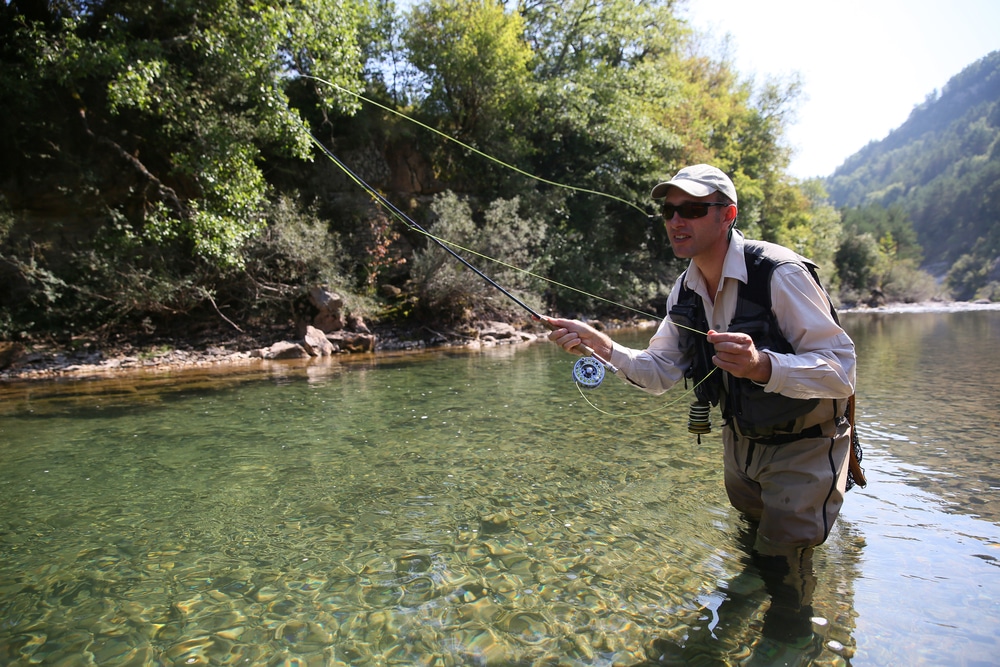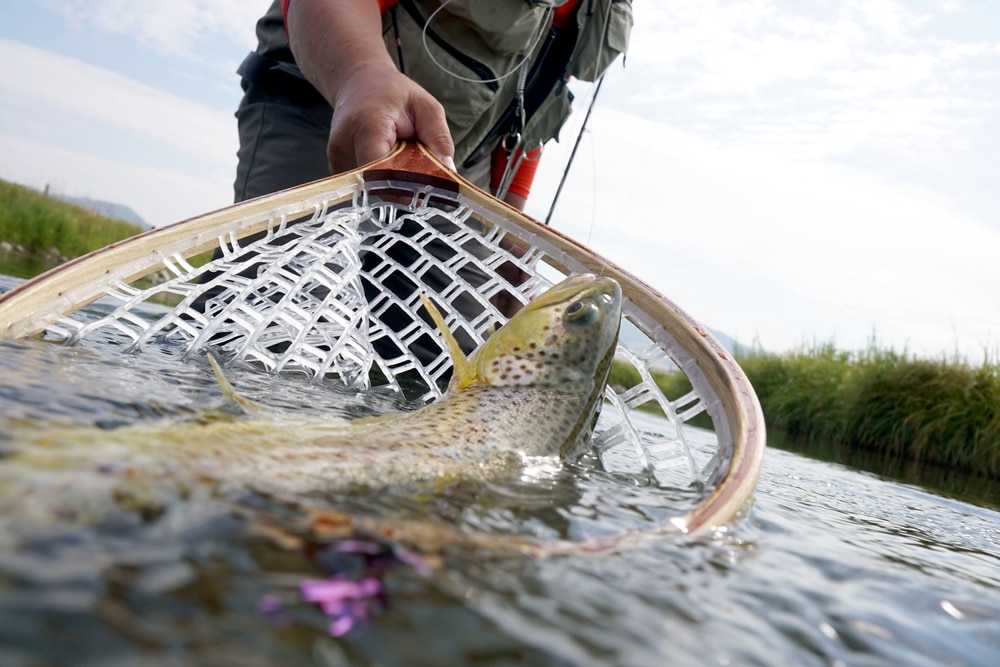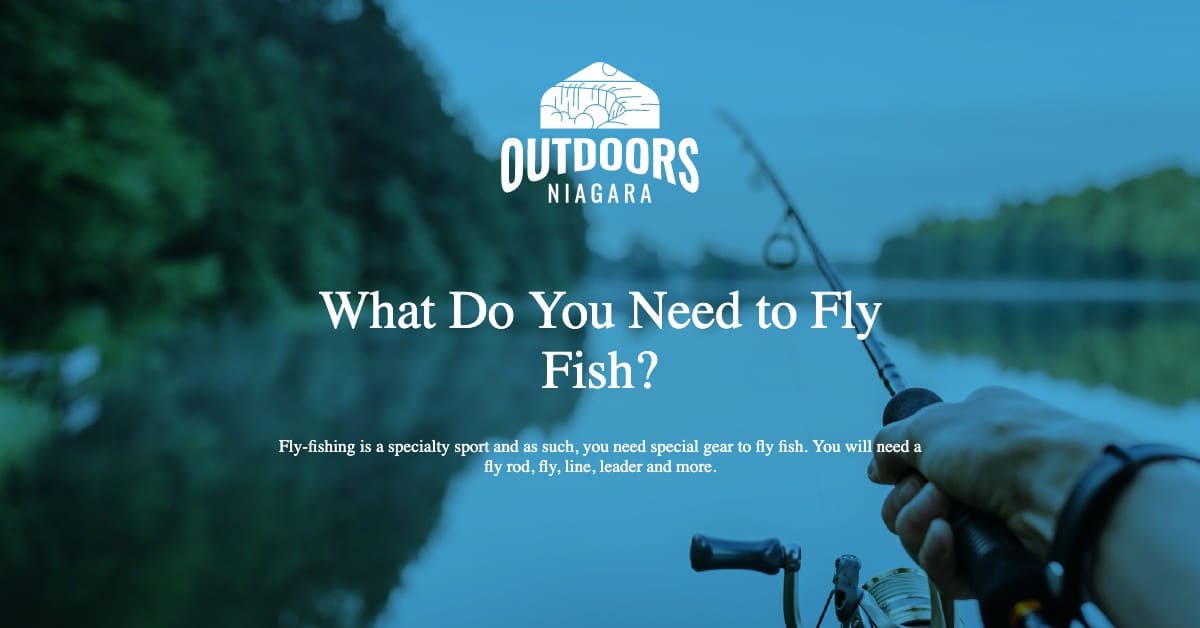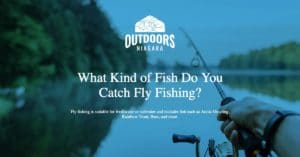Fly-fishing is a specialty sport and as such, you need special gear to fly fish.
You will need a fly rod, fly, line, and leader.
That list is the basics of what you need to fly fish.
There is other equipment that will help make the process more enjoyable and successful.
We discuss those below.

Contents
Basic Fly-Fishing Equipment
The Rod
The most important tool for fly-fishing is a fly rod.
The rod is different from other types of fishing rods in that is designed to cast without a sinker.
The weight of the fly is enough to propel the line great distances.

The Flies
You will also need a fly or a set of flies. The weight of the fly is important, and you must match the flyweight to the rod.
Most fly rods will list the flyweight range on the blank.
There are four basic groups of flies, and they are mimics of the insect order Diptera (flies.)
Flat-winged flies – midges, bottle flies, houseflies, etc. The wings are flat when the fly is at rest.
Trichoptera or attic flies – Caddis and sedge flies – These are characterized by a tent-like appearance of the wings while the fly is at rest.
Plecoptera or Stoneflies and salmon flies – The wings are scaled
Ephemeroptera – May flies – the wings are held upright or vertical over the body when the fly is at rest.
Most of the flies you encounter in a bait store are going to be mimics of these four groups of real flies.
In fly-fishing terms, we call them patterns and the man-made fly is a mimic of the real fly.
We mimic real flies because the fish are highly programmed to recognize these flies as food.
That means if you do a good job of mimicking the real fly, your fly-fishing fly will be more successful, and you will catch more fish.
The Fly Reel
Fly reels are different from other reel types.
They are different because most of the fish that you target with a fly rod are strong and put up a long fight.
That translates into a fish that will “run” striping line off the arbor of the reel.
The battle between a fly-fishing angler and fish is long.
It is a repeating of hauling the fish in and the fish stripping line off the reel.
Each repetition wears the fish until it either escapes the hook or is captured by the angler.
Fly reels must match the weight of the fly rod. A six-weight rod needs a line that is 5-7 pounds.
You also want a quality reel that offers a smooth gearing and a drag that is powerful enough to slow the line stripping and tire the fish without it getting away.
Fly Backing, Fly Line, Tippet, and Leader
The line set up on a fly rod begins with backing, which is generally a Dacron line.
It has the job of extending the total length of the line on the reel.
Backing is often 12-30 pound test.
To the backing is attached another type of line.
Many fly fishermen use braided line and attach it to the backing, but before braid became so popular, mono or fluorocarbon was used.
Braided line is much stronger given its diameter, but mono and fluorocarbon are thinner, and you can add more of these to the arbor than braided line.
The last part of fly-fishing line is the leader, which is often made of mono or fluorocarbon.
It is a short segment of line, usually less than 12-feet onto which you tie the fly.
That concludes the basic gear needed to fly fish successfully.
There are other pieces of gear that make that process more comfortable and successful.
Those include:
Misc Gear for Fly Fishing
Waders
Wading in the river is a given for fly fishermen.
You will need to wade in the river to position yourself at the best junctions to fly fish.
You may need to stand in the water for longer periods while you cast.
The options include:
Rubber Boots – are okay for shallow water, but they limit where you can go in the water without getting your feet wet.
Hip Waders – are traditional for fly-fishing as they allow you to wade in waters that are thigh deep. They are also safer than wearing chest waders because they do not hold as much water should you fall into the river or lake.
Chest Waders – is the more popular choice for today’s fly fisherman. They allow you to ford deeper creeks and rivers to reach sandbars and other strategic fishing positions. They can drag you down the river, though, if you fall in and the current is strong.
Fly-fishing Vest
A fly-fishing vest is a replacement for a tackle box used in other forms of fishing.
Because you are often waist-deep in the river you do not want to have to continually wade back to the shore to locate your tackle box to change fly patterns. Instead, you wear the gear you need.
Inside the fly-fishing vest, you keep an assortment of flies generally in a small plastic box or threaded into a fly holder in your hat or vest. You also need a small spool of leader or tippet and a pair of scissors or knife.
A fly-fishing vest is a handy tool that allows you to stay put and re-rig your pole.
The last of the major accessories is a pair of polarized sunglasses.
These are essential for situations where you spot-fish.
Literally, you spot the fish and then cast in its general area.
Polarized sunglasses reduce or remove the glare from the water, so you can see better.
FAQ
What Are the Seven Basic Things You Need for Fly Fishing?
The seven most important items you need to fly fish are a fly rod, fly reel, backing, line (braided or mono or fluorocarbon,) a vest that holds your gear, waders, and an extra asset would be polarized sunglasses.
What Kind of Water Do Fish Need to Fly?
You can fly fish in all kinds of water.
Fly-fishing anglers are successful in rivers of all sizes, lakes, wetlands, and marshes, and in saltwater locations.
Inshore and offshore are two of the best fly-fishing locations for saltwater fly-fishing.
You approach how you rig the fly rod for different types of water.
Clearwater vs. tea-stained water, vs. choppy water, and freshwater vs. saltwater.
The only type of water that makes fly-fishing hard or nearly impossible is water that has super high turbidity.
For example, there are rivers in Alaska where the spring melt waters are so full of particulate matter that fish don’t live there.
They may return to those water after the meltwater resides or not.
Can You Fly Fish in Still Water?
Absolutely. Still, water is an awesome body of water for fly-fishing.
Still water, such as back pools, oxbows, and lakes are where you find big trout, bass, and smaller game fish such as bluegills.
The trick to fishing still waters is often a longer leader and the way that you present the fly to the water’s surface.
Is Fly-Fishing Good for Beginners?
Yes, Fly-fishing is good for beginners. The first time I went fly-fishing, I did so in Alaska with a guide.
I spent two days on the fabled Kenai River fishing for salmon. I had no experience with fly-fishing and my guide was patient and taught me everything I needed to know.
That experience ignited a passion for fly-fishing and one that I enjoy as often as I can.
Final Thoughts
Fly-fishing is a sport that seems mystical. Something that has magic to it.
A treasured skill that you pass from father to son, and without that link, you have no hope to master fly-fishing.
The honest truth is that fly-fishing is not that difficult. It seems overly complicated because it is different from other forms of fishing.
The big difference is that fly-fishing is a closer blend of fish-nature-angler.
It is the enhanced knowledge of living flies and aquatic insects that makes fly-fishing elusive.
The flies are nothing more than mimics of aquatic insects – those flies that live most of their lives in the water and then emerge as adults to mate and reproduce.
Once you understand that and how to match your fly to the current hatching, you are golden.
In fly-fishing, we refer to that as matching the hatch, which simply means that we tie a fly on the end of our line that matches the flies that are currently active wherever we fish.
The other thing to know is the cycle of emergence, which is simply the different times of the season or year in which one species of fly emerges as an adult to mate.
The different types of flies do not emerge all at once, so you have to look and see what is flying around and then match your fly to that body style – flat wing, roofed wing, scaled wing, and vertical wings.
The casting part, is something people make a big deal about and the honest truth is that it takes practice like everything else.
That process is something a guide can show you, and then you can practice it until you master it.
There is plenty of room in fly-fishing for beginners.
We were all once novice fishermen or anglers, and today, the sport is growing rapidly.







